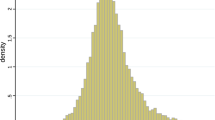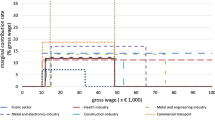Abstract
This study assesses whether pension vesting and lock-in regulations affect participation in employer-sponsored pension plans. Specifically, the effects of Canadian reforms enacted during the 1980s and 1990s are investigated, which reduced vesting and lock-in requirements from employees being at least 45 years old and having ten years of continuous plan membership to two years of membership irrespective of age. To credibly identify these effects, the analysis exploits inter-provincial variation in the timing of the pension reforms using a difference-in-differences approach. The results show that employees aged 25–54 responded positively to the added protection of their pension wealth by increasing plan participation, despite the general trend of declining occupational pension coverage during this time. However, these changes also crowded out contributions to other retirement savings accounts. The implications of these findings for the optimal design of private pension systems are discussed.


Similar content being viewed by others
Notes
See, for example, Gustman et al. (1994) for an earlier survey of this literature.
In Canada, the predominant type of EPP is called a registered pension plan (RPP). These programs may be defined-benefit, defined-contribution, or hybrid arrangements for employers to provide pension benefits to their employees upon retirement in the form of periodic payments. RPPs offer front-loaded incentives to contribute, in other words employee contributions are tax-deductible and employer contributions are non-taxable; the taxes are paid on income when funds are eventually withdrawn from the accounts (similar to 401(k)s in the United States). The majority of RPPs in Canada are defined-benefit arrangements (Drolet and Morissette 2014).
Several studies that estimate the effects of EPPs on total savings include: Sillamaa and Veall (2001), Veall (2001), Milligan (2002), and Messacar (2015) for Canada; Poterba et al. (1994, 1995), Engen et al. (1994, 1996), Venti and Wise (1996), Gale (1998), Benjamin (2003), Engelhardt and Kumar (2011), and Gelber (2011) for the United States; and Alessie et al. (1997), Euwals (2000), and Chetty et al. (2014) for European countries. Bernheim (2002) provides a comprehensive survey of this literature, and considers the factors that vary across these studies that may contribute to their differences in results.
RRSPs are tax-preferred accounts that individuals set up and maintain through financial institutions, which provide front-loaded incentives to contribute (similar to individuals retirement accounts [IRAs] in the United States). RRSPs are widely-used even among EPP members; for example, Messacar (2015) estimates that approximately half of EPP members contribute to RRSPs in a given year among a sample of frequent tax filers spanning 1991–2010.
Employee contributions to EPPs are observed since 1986 in administrative tax records. However, Morissette and Ostrovsky (2006) show that the omission of employer contributions leads to significant under-estimation of EPP coverage, of up to 17% for men aged 35–54 and 11% for women aged 35–54, since many plans are financed entirely by the employers. Other studies that assess trends in EPP coverage through the 1980s and 1990s include Morissette and Drolet (2000) and Morissette and Ostrovsky (2006, 2007).
Using more dimensions (notably educational attainment) would increase the number of groups to the point where the sample sizes within cells become too small to draw meaningful inferences.
Unfortunately no dataset exists that combines detailed income and expenditures information with a wide range of years and observations to implement this study. The LMAS and SLID provide many years of observations but lack expenditures data, whereas the FAMEX and SHS were carried out infrequently. As the analysis will show, below, the main findings are reproducible in both datasets.
References
Akyeampong EB (2002) Unionization and fringe benefits. Perspectives 2002 (Summer), Statistics Canada Catalogue no. 75-001-XIE
Alessie RJM, Kapteyn A, Klijn F (1997) Mandatory pensions and personal savings in the Netherlands. De Economist 145(3):291–324
Arpaia A, Kiss A, Palvolgyi B, Turrini A (2015) Labour mobility and labour market adjustment in the EU. Policy Paper No. 106, Institute for the Study of Labor
Benjamin DJ (2003) Does 401(k) eligibility increase saving? Evidence from propensity score subclassification. J Public Econ 87(56):1259–1290
Bernheim BD (2002) Taxation and saving. In: Auerbach AJ, Feldstein M (eds) Handbook of public economics. Elsevier, pp 1173–1249
Bernheim BD, Fradkin A, Popov I (2015) The welfare economics of default options in 401(k) plans. Am Econ Rev 105(9):2798–2837
Beshears J, Choi JJ, Laibson D, Madrian BC (2014) Does front-loading taxation increase savings? Evidence from Roth 401(k) introductions. Working Paper n. 20783, National Bureau of Economic Research
Bloom DE, Freeman RB (1992) The fall in private pension coverage in the United States. Am Econ Rev 82(2):539–545
Calvet L, Campbell J, Sodini P (2009) Measuring the financial sophistication of households. Am Econ Rev 99(2):393–398
Carroll GD, Choi JJ, Laibson D, Madrian BC, Mertick A (2009) Optimal defaults and active decisions. Q J Econ 124(4):1639–1674
Chetty R, Friedman JN, Leth-Petersen S, Nielsen T, Olsen T (2014) Active vs. passive decisions and crowdout in retirement savings accounts: evidence from Denmark. Q J Econ 129(3):1141–1219
Choi JJ, Laibson D, Madrian BC, Mertick A (2003) Optimal defaults. Am Econ Rev 93(2):180–185
Choi JJ, Laibson D, Madrian BC, Mertick A (2004) For better or for worse: default effects and 401(k) savings behavior. In: Wise DA (ed) Perspectives on the economics of aging. University of Chicago Press, Chicago
Cooper RW, Ross TW (2002) Pensions: theories of underfunding. Labour Econ 8(6):667–689
Drolet M, Morissette R (2014) New facts on pension coverage in Canada. Insights on Canadian Society, Statistics Canada Catalogue no. 75-006-X
Engelhardt GV, Kumar A (2011) Pensions and household wealth accumulation. J Hum Resour 46(1):203–236
Engen EM, Gale WG, Scholz JK (1994) Do saving incentives work? Brook Pap Econ Act 1994(1):85–180
Engen EM, Gale WG, Scholz JK (1996) The illusory effects of saving incentives on saving. J Econ Perspect 10(4):113–138
Euwals R (2000) Do mandatory pensions decrease household savings? Evidence from the Netherlands. De Economist 148(5):643–670
Even W, Macpherson D (2007) Defined contribution plans and the distribution of pension wealth. Industrial Relations: A Journal of Economy and Society 46(3):551–581
Gale WG (1998) The effects of pensions on household wealth: a reevaluation of theory and evidence. J Polit Econ 106(4):706–723
Gallo JG, Lockwood LJ (1995) Determinants of pension funding and asset allocation decisions. J Financ Serv Res 9(2):143–158
Gelber AM (2011) How do 401(k)s affect saving? Evidence from changes in 401(k) eligibility. Am Econ J Econ Pol 3(4):103–122
Gougeon P (2009) Shifting pensions. Perspectives 2009 (Spring), Statistics Canada Catalogue no. 75-001-XIE
Gul F, Pesendorfer W (2001) Temptation and self-control. Econometrica 69(6):1403–1435
Gunderson M, Luchak A (2001) Employee preferences for pension plan features. J Lab Res 22(4):795–808
Gustman AL, Steinmeier TL (1992) The stampede toward defined contribution pension plans: fact or fiction? Industrial Relations: A Journal of Economy and Society 31(2):361–369
Gustman AL, Mitchell OS, Steinmeier TL (1994) The role of pensions in the labor market: a survey of the literature. Ind Labor Relat Rev 47(3):417–438
Huberman G, Iyengar SS, Jiang W (2007) Defined contribution pension plans: determinants of participation and contribution rates. J Financ Serv Res 31(1):1–32
Johnson RW (1996) The impact of human capital investments on pension benefits. J Labor Econ 14(3):520–554
Kiker BF, Rhine SLW (1990) Income, taxes and employer pension contributions. Appl Econ 22(5):639–651
Laibson D (1997) Golden eggs and hyperbolic discounting. Q J Econ 112(2):443–478
Luchak AA, Fang T, Gunderson M (2004) How has public policy shaped defined-benefit pension coverage in Canada? J Lab Res 25(3):469–484
Lusardi A, Mitchell OS (2010) How ordinary consumers make complex economic decisions: financial literacy and retirement readiness. Working Paper 2010/11, Center for Financial Studies
Lusardi A, Michaud P-C, Mitchell OS (2013) Optimal financial knowledge and wealth inequality. Working Paper n. 18669, National Bureau of Economic Research
Lyons ST, Schweitzer L, Ng ESW, Kuron LKJ (2012) Comparing apples to apples: a qualitative investigation of career mobility patterns across four generations. Career Development International 17(4):333–357
Madrian BC, Shea DF (2001) The power of suggestion: inertia in 401(k) participation and savings behavior. Q J Econ 116(4):1149–1187
Messacar D (2015) Do workplace pensions crowd out other retirement savings? Evidence from Canadian tax records. Analytical Studies Branch Research Paper Series, no. 371. Statistics Canada Catalogue no. 11F0019M
Milligan K (2002) Tax-preferred savings accounts and marginal tax rates: evidence on RRSP participation. Can J Econ 35(3):436–456
Morissette R, Drolet M (2000) Pension coverage and retirement savings of young and prime-aged workers in Canada: 1986-1997. Income Research Paper Series no. 9, Statistics Canada Catalogue no. 75F0002MIE
Morissette R, Ostrovsky Y (2006) Pension coverage and retirement savings of Canadian families, 1986 to 2003. Analytical Studies Branch Research Paper Series, no. 286. Statistics Canada Catalogue no. 11F0019M
Morissette R, Ostrovsky Y (2007) Pensions and retirement savings of families. Perspectives 2007 (Winter), Statistics Canada Catalogue no. 75–001-XIE
Mullock K, Turcotte J (2012) Financial literacy and retirement savings. Working Paper 2012-01, Department of Finance Canada
OECD (2012) OECD pensions outlook 2012, Organisation for Economic Co-operation and Development
Poterba JM, Venti SF, Wise DA (1994) 401(k) plans and tax-deferred saving. In: Wise DA (ed) Studies in the economics of aging. University of Chicago Press, Chicago, pp 105–142
Poterba JM, Venti SF, Wise DA (1995) Do 401(k) contributions crowd out other personal saving? J Public Econ 58(1):1–32
Poterba JM, Rauh J, Venti SF, Wise DA (2007) Defined contribution plans, defined benefit plans, and the accumulation of retirement wealth. J Public Econ 91(10):2062–2086
Sillamaa M-A, Veall MR (2001) The effect of marginal tax rates on taxable income: a panel study of the 1988 tax flattening in Canada. J Public Econ 80(3):341–356
Standard Life (2011) Summary of pension legislation. Canada, The Standard Life Assurance Company of
Statistics Canada (2017) User guide for the Survey of Household Spending, 2015. Statistics Canada Catalogue no. 62F0026M
Taubman P (1985) Determinants of pension benefits. In: Wise DA (ed) Pensions, labor, and individual choice. University of Chicago Press, Chicago
Thaler RH, Benartzi S (2004) Save more tomorrow™: using behavioral economics to increase employee saving. J Polit Econ 112(1):S164–S187
Veall MR (2001) Did tax flattening affect RRSP contributions? Can J Econ 34(1):120–131
Venti SF, Wise DA (1996) The wealth of cohorts: retirement saving and the changing assets of older Americans. Working Paper n. 5609, National Bureau of Economic Research
Author information
Authors and Affiliations
Corresponding author
Ethics declarations
Conflict of Interest
The author declares that he has no conflict of interest.
Additional information
This article is based on a study carried out while the author was a Ph.D. candidate in the Department of Economics at the University of Toronto. The author thanks Dwayne Benjamin and Kory Kroft for helpful comments provided on an earlier version of this article, as well as Shin-Yi Chou and the referees for the valuable suggestions. The views and opinions expressed in this article are those of the author and do not necessarily reflect the views of Statistics Canada or the Government of Canada.
Rights and permissions
About this article
Cite this article
Messacar, D. The Effects of Vesting and Locking in Pension Assets on Participation in Employer-Sponsored Pension Plans. J Labor Res 39, 178–200 (2018). https://doi.org/10.1007/s12122-018-9265-z
Published:
Issue Date:
DOI: https://doi.org/10.1007/s12122-018-9265-z




